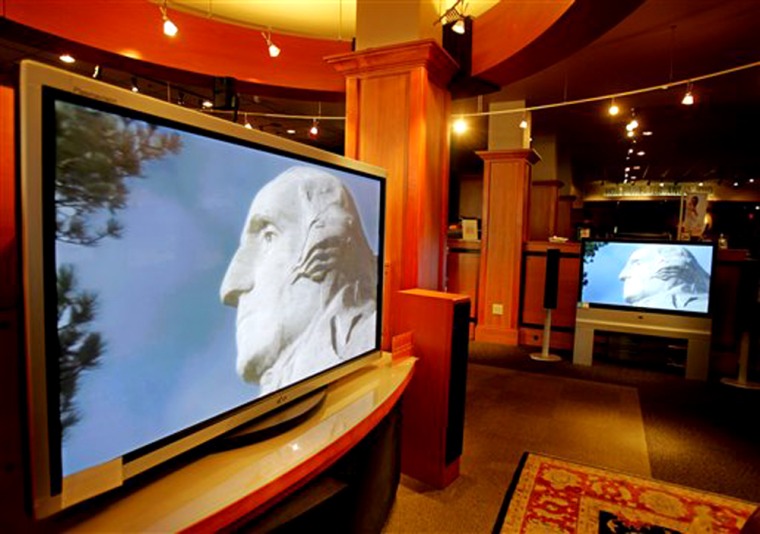Bud Werner and his wife are longtime movie buffs. For more than a year, he pined for a flat-panel television, thrilled by 60-inch screens thin enough to hang on a wall and turn his living room into a mini-movie theater.
But he couldn’t overcome sticker shock — some flat panels were selling for as much as $20,000 at first, as much as a new car. Like a lot of fans of flat-panel TVs, Werner, who owns a sign-making business, held off buying.
Until now, that is.
Prices for flat panels have finally begun to tumble — by as much as 35 percent in the past year — as soaring demand for the two leading flat-panel technologies, plasma and liquid crystal display, or LCD, attracts a host of new competitors.
“I’m excited,” said Werner, 54, whose patience was rewarded this month when he bought a 50-inch plasma television at Best Buy for $3,800. “We already have the wall picked out where it’s going to hang.”
Lesser-known brands, such as Westinghouse Electric Co., Regent USA’s Maxent, Syntax Corp.’s Olevia and Norcent Micro Inc. are slashing prices to compete against more-established names like Sharp Corp. and Sony Corp., forcing them, in turn, to charge less.
Semiconductors and other TV components also are getting cheaper, and the industry continues to find ways to trim production costs.
Now, a 42-inch liquid crystal model retails for about $4,200 on average, and the same-sized high-definition plasma sells for around $2,900, said Riddhi Patel, senior analyst for iSuppli, a market research firm in El Segundo, Calif.
Still too expensive? Price-conscious consumers shouldn’t worry, analysts say, as flat-panel prices have yet to bottom out.
Some major retail chains continue to charge a premium for plasma and liquid crystal sets, pocketing 25 percent profits on larger models, Patel said.
“There is plenty of room for retailers to squeeze more out of their profit margins and attract customers,” she said.
Proof that flat-panel TVs is a boon for retailers can be found in their earnings statements. Best Buy Co. saw an 85 percent jump in first-quarter profits due in part to skyrocketing sales of flat-panel televisions, while struggling electronics retailer Circuit City Stores Inc. saw triple-digit increases.
Representatives for Best Buy, Wal-Mart Stores Inc. and Costco Wholesale Corp., did not respond to requests for comment, while Bill Cimino of Circuit City refused to discuss profit margins, though he did say more price reductions are expected.
The price war, meanwhile, is taking a toll on flat-panel manufacturers. Sony blamed increased competition from Asian manufacturers who produce cheaper goods, including flat-panels TVs, when it reduced its full-year forecast by 90 percent. Last month, Sony, Toshiba Corp., and Hitachi Ltd. reported quarterly losses.
Some manufacturers have agreed to share risk and expense. Hitachi and Matsushita Electric Industrial Co., the maker of Panasonic televisions, began jointly making LCD televisions in February, as did Sharp and Fujitsu Ltd.
Despite the competitive environment, the companies continue to invest heavily in flat panels knowing that once the market matures they stand to cash in.
About 20.8 million flat-panel TVs will be sold this year worldwide, almost double the 10.9 million units sold in 2004. Sales next year should rise 47 percent, iSuppli said.
Though CRTs have served consumers well for a half-century, flat panels are appealing because they take less space and can be hung on walls.
Misperception may also play a role.
When it comes to picture, most analysts say CRTs are just as good as flat panels, yet many consumers are under the assumption that flat panels are all high definition and thus offer better picture quality. In retail showrooms, flat panels typically display high-definition digital content, so they look superior to CRTs.
Consumers don’t always know that some flat panels can’t receive high definition, or that CRTs can be formatted to get such programming.
When it comes to performance among flat-panel makers, paying more doesn’t necessarily mean a better picture, said Eric Haruki, an analyst for research firm IDC.
More than 90 percent of the world’s LCD panels are supplied by five companies, so top-tier brands and generics often share the same components, according to Haruki.
“Some of these companies buy top-notch components from the big players and rebrand them,” Haruki said. “The technology is pretty good across the board.”
Greg Gudorf, Sony’s vice president of television marketing, insists top-tier manufacturers have an expertise lesser-known brands can’t match.
“What is their manufacturing expertise in processing video signals?” Gudorf asked. “That’s where Sony’s heritage comes in. We know how to make a picture look good.”
But James Li, chief executive of Syntax, argues that heritage is meaningless when it comes to new technology.
“We all entered the LCD era on the same playing field,” he said. “Everybody is working with the same technology. Consumers have already learned that the brand name is not the single most important factor in their purchase.”
There is just as much debate over whether to buy now or wait until prices drop further.
Patel is in the market for a new television, but she is waiting until after holiday shopping peaks. She said retailers are apt to offer their best deals then.
Russ Johnston, senior vice president of marketing for Pioneer Electronics Inc., agrees the cost-conscious can wait.
But for those who want the best TV experience in time for the upcoming football season and baseball playoffs, there’s no better time to buy.
“If you look at August through November, those are the best TV months,” Johnston said. “Sports fans are going to invite people over and want to show off their new TV. They’re done waiting.”
